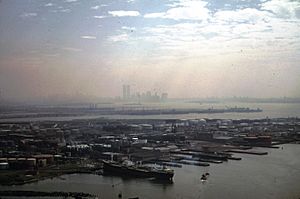Port Johnston Coal Docks facts for kids
The Port Johnston Coal Docks were a very important place built in Bayonne, New Jersey, right on the Kill van Kull waterway. They were built in 1864 by a company called the Central Railroad of New Jersey.
This huge coal dock was about 2,750 feet (838 meters) long! It was named after the company's president, John Taylor Johnston. You can still find places named after him today, like Johnston Avenue. When it was finished in 1866, it was the biggest coal dock in the whole world. It gave jobs to 200 people, many of whom were Irish immigrants. Their main job was to move coal from train cars onto special boats called barges. These barges then carried the coal across Upper New York Bay to New York City.
Contents
The Great Strike of 1877
On July 26, 1877, something big happened at the Port Johnston Coal Docks: the first major workers' strike in Bayonne. A strike is when workers stop working to protest their working conditions or pay.
Why the Workers Went on Strike
The Lehigh and Wilkesbarre Coal Company had bought the docks in 1876. To save money, they decided to cut the workers' wages. This meant the workers would earn less money for the same amount of work. The workers were not happy about this and decided to stop working.
How the Strike Ended
The company quickly fired all the striking workers. They then brought in German immigrants from New York City to take their places. However, after working for just one day at the lower wages, these new workers also decided it wasn't worth it and quit.
Bayonne's Mayor, Henry Meigs, Jr., and Father Thomas Killeen from St. Mary's Church stepped in to help. They worked to prevent a riot and find a peaceful solution. By early August, Mayor Meigs had worked out an agreement with the company. This agreement ended the strike peacefully, and the workers likely got their wages back or a fair compromise.
Later Years and What's There Now
During World War II, the Port Johnston area was used as a prisoner-of-war camp for Italian soldiers.
Since 1966, the area around Port Johnston has been used for storing and moving oil. A company called Gordon Terminal Service operates the large oil storage tanks and marine transfer operations there today.


